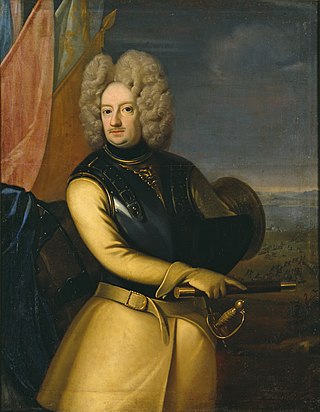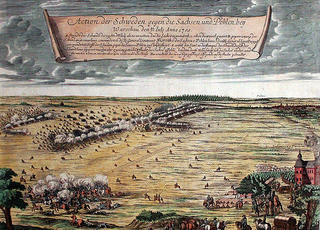
The Battle of Lesnaya was one of the major battles of the Great Northern War. It took place on October 9 [O.S. September 28] 1708 between a Russian army of between 26,500 and 29,000 men commanded by Peter I of Russia, Mikhail Mikhailovich Golitsyn, Aleksandr Danilovich Menshikov, Rudolph Felix Bauer and Nikolai Grigorovitj von Werden and a Swedish army of about 12,500 men commanded by Adam Ludwig Lewenhaupt and Berndt Otto Stackelberg, at the village of Lesnaya, located close to the border between the Polish–Lithuanian Commonwealth and Russian Empire. The Swedes were escorting a supply column of more than 4,500 wagons for their main army in Ukraine.

The Great Northern War (1700–1721) was a conflict in which a coalition led by the Tsardom of Russia successfully contested the supremacy of the Swedish Empire in Northern, Central and Eastern Europe. The initial leaders of the anti-Swedish alliance were Peter I of Russia, Frederick IV of Denmark–Norway and Augustus II the Strong of Saxony–Poland–Lithuania. Frederick IV and Augustus II were defeated by Sweden, under Charles XII, and forced out of the alliance in 1700 and 1706 respectively, but rejoined it in 1709 after the defeat of Charles XII at the Battle of Poltava. George I of Great Britain and the Electorate of Hanover joined the coalition in 1714 for Hanover and in 1717 for Britain, and Frederick William I of Brandenburg-Prussia joined it in 1715.

The Battle of Narva on 30 November [O.S. 19 November] 1700 was an early battle in the Great Northern War. A Swedish relief army under Charles XII of Sweden defeated a Russian siege force three to four times its size. Previously, Charles XII had forced Denmark–Norway to sign the Treaty of Travendal. Narva was not followed by further advances of the Swedish army into Russia; instead, Charles XII turned southward to expel August the Strong from Livonia and Poland-Lithuania. Tsar Peter the Great of Russia took Narva in a second battle in 1704.

Gdov is a town and the administrative center of Gdovsky District in Pskov Oblast, Russia, located on the river Gdovka, just 2 kilometers (1.2 mi) from its outflow into Lake Peipus. Population: 3,465 (2021 Census); 4,379 (2010 Census); 5,171 (2002 Census); 6,009 (1989 Soviet census).

Count Magnus Stenbock was a Swedish field marshal (Fältmarskalk) and Royal Councillor. A commander of the Carolean Army during the Great Northern War, he was a prominent member of the Stenbock family. He studied at Uppsala University and joined the Swedish Army during the Nine Years' War, participating in the Battle of Fleurus in 1690. After the battle, he was appointed lieutenant colonel, entered Holy Roman service as Adjutant General, and married Eva Magdalena Oxenstierna, daughter of statesman Bengt Gabrielsson Oxenstierna. Returning to Swedish service he received colonelcy of a regiment in Wismar, and later became colonel of the Kalmar and then Dalarna regiments.

Count Carl Gustav Rehnskiöld was a Swedish Field Marshal (fältmarskalk) and Royal Councillor. He was mentor and chief military advisor to King Charles XII of Sweden, and served as deputy commander-in-chief of the Carolean Army, an army he assisted both in its education and development.

The Battle of Kliszów took place on July 19, 1702, near the village of Kliszów in the Polish–Lithuanian Commonwealth during the Great Northern War. A Swedish army under the command of King Charles XII of Sweden defeated a Polish–Saxon army twice the size that was led by King Augustus II the Strong.

The Crossing of the Düna took place during the Great Northern War on July 19, 1701 near the city of Riga, present-day Latvia. The Swedish king Charles XII was in hot pursuit of king Augustus II the Strong of the Polish–Lithuanian Commonwealth and Saxony. The crossing was easily made, and the coalition troops were quickly broken and retreated.

The Battle of Erastfer took place on 29 December 1701 (O.S.) / 30 December 1701 / 9 January / 1702 (N.S.) near Erastfer in eastern Swedish Livonia between a Russian force of around 13,000 regulars along with 6,000 irregulars led by general Boris Sheremetev and a Swedish force of about 3,470 men, under the command of Wolmar Anton von Schlippenbach. The Swedes were defeated, with a loss of 1,000 men killed and captured along with all their artillery pieces. The Russians sustained about 1,000 killed along with another 2,000 wounded.

The Battle of Warsaw was fought on 31 July 1705 near Warsaw, Polish–Lithuanian Commonwealth, during the Great Northern War and Swedish invasion of Poland (1701–1706). The battle was part of a power struggle for the Polish–Lithuanian throne. It was fought between Augustus II the Strong and Stanisław Leszczyński and their allies. Augustus II entered the Northern war as elector of Saxony and king of the Polish–Lithuanian Commonwealth, and had formed an alliance with Denmark–Norway and Russia. Stanisław Leszczyński had seized the Polish throne in 1704, with the support of the Swedish army of Charles XII of Sweden. The struggle for the throne forced the Polish nobility to pick sides; the Warsaw Confederation supported Leszczyński and Sweden, and the Sandomierz Confederation supported Augustus II and his allies. The conflict resulted in the Polish civil war of 1704–1706.

Slantsevsky District is an administrative and municipal district (raion), one of the seventeen in Leningrad Oblast, Russia. It is located in the southwest of the oblast and borders with Ida-Viru County of Estonia in the west, Kingiseppsky District in the north, Volosovsky District in the northeast, Luzhsky District in the east, Plyussky District of Pskov Oblast in the south, and Gdovsky District, also of Pskov Oblast, in the southwest. The area of the district is 2,191.1 square kilometers (846.0 sq mi). Its administrative center is the town of Slantsy. Population : 10,038 (2010 Census); 10,480 ; 10,974 (1989 Soviet census).

Gdovsky District is an administrative and municipal district (raion), one of the twenty-four in Pskov Oblast, Russia. It is located in the northwest of the oblast and borders with Slantsevsky District of Leningrad Oblast in the north, Plyussky District in the east, Strugo-Krasnensky District in the southeast, and with Pskovsky District in the south. Lake Peipus forms the border with Estonia in the west. The area of the district is 3,400 square kilometers (1,300 sq mi). Its administrative center is the town of Gdov. Population: 12,792 (2010 Census); 17,715 ; 19,842 (1989 Soviet census). The population of Gdov accounts for 34.2% of the district's total population.

The Landing at Humlebæk took place on August 4, 1700, in the Swedish invasion of Denmark during the Great Northern War 1700-1721. It was the first offensive during the war by the Swedish army, and it was directly led by Charles XII of Sweden commanding the right flank and Arvid Horn together with Carl Gustav Rehnskiöld at the left. The Swedes were victorious and routed the Danish forces led by Jens Rostgaard.

The Swedish invasion of Poland (1701–1706), also known as Charles XII's invasion of Poland or the Polish front of the Great Northern War, was a conflict in eastern Europe overshadowed by the ongoing Great Northern War fought between the Swedish Empire against the Russian Empire, Denmark-Norway, Saxony and the Polish–Lithuanian Commonwealth. The Polish front was a major part of the greater conflict, and it included some decisive battles in favor of the Swedes that contributed to the length of the war.
The Battle of Walk on July 8, 1657 between forces of Sweden commanded by Friedrich von Löwen on one side, and Russian forces led by stolnik Matvey Sheremetyev, who for the first time in his career commanded an army by himself, on the other side. The largest part of the Russian army disobeyed Sheremetyev and left the battle at the beginning, forcing him to rely on the 250 reiters of Colonel Denis Fonvizin, who played the key role in the breakthrough and allowed the rest of the army to escape. The Swedish forces won the battle, and according to their sources they defeated an army of 8,000 men, 32 standards, banners and other field declarations had been captured in the battle and 1,500 Russians were dead or wounded along with their commander Matvey Sheremetyev, who later died in captivity.

The Campaign of Grodno was a plan developed by Johann Patkul and Otto Arnold von Paykull during the Swedish invasion of the Polish–Lithuanian Commonwealth, a part of the Great Northern War. Its purpose was to crush Charles XII's army with overwhelming force in a combined offensive of Russian and Saxon troops. The campaign, executed by Peter I of Russia and Augustus II of Saxony, began in July 1705 and lasted almost a year. In divided areas the allies would jointly strike the Swedish troops occupied in Poland, in order to neutralize the influence the Swedes had in the Polish politics. However, the Swedish forces under Charles XII successfully outmaneuvered the allies, installed a Polish king in favor of their own and finally won two decisive victories at Grodno and Fraustadt in 1706. This resulted in the Treaty of Altranstädt (1706) in which Augustus renounced his claims to the Polish throne, broke off his alliance with Russia, and established peace between Sweden and Saxony.
The Battle of Varja took place on November 7, 1700, close to the villages of Varja and Aa, in the Duchy of Estonia of the Swedish Empire during the Estonian campaign of the first year in the Great Northern War.

The Battle of Bronnitsy was part of the Ingrian War.

The Battle of Gdov in the Russo-Swedish War took place on September 16, 1657 in Gdov. The battle was a clear victory for Prince Ivan Khovansky of the Tsardom of Russia over Swedish Governor-General Count Magnus De la Gardie allowing the Russians to regroup after a brief resurgence of Swedish resistance.
















